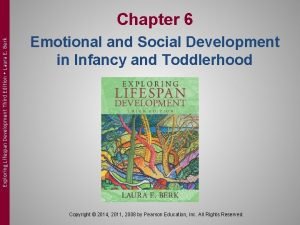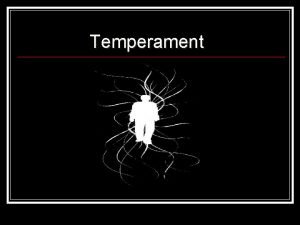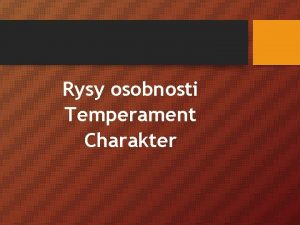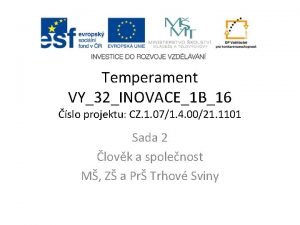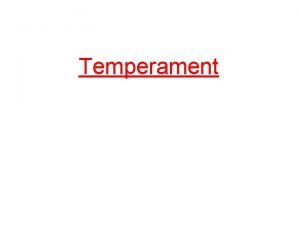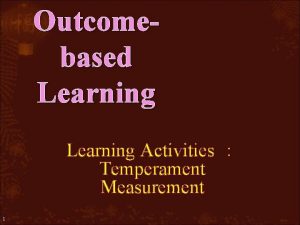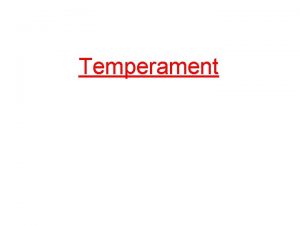Crosscultural Differences in Parental Reactions to Temperament Displays

















- Slides: 17

Cross-cultural Differences in Parental Reactions to Temperament Displays and Relations to Child Temperament The Joint Effort Toddler Temperament Consortium I. Acar, A. Prokasky, S-Y. Han, B. Huitron, C. Gonzales-Salinas, S. P. Putnam, B. Linhares, M. Majdandzic, R. Montirosso, K. Heinonen, E. Kozlova, Z. Wang, S. Casalin, E. Ahmetoglu, O. Benga, C. de Weerth, & M. Gartstein Occasional Temperament Conference Seattle, WA October 21 -22, 2016

Background • Parents responses to children's temperament may play an important role in children’s development (Roberts, 1999). • Supportive responses (e. g. , affirming of emotional expressions) are associated with positive social functioning (Eisenberg et al. , 1996; Mc. Elwain, Halberstadt, & Volling, 2007) • Unsupportive responses (e. g. , minimizing children’s emotional expression) are associated with lower levels of social competence and higher levels of problem behaviors (Fabes et al. , 2001; Eisenberg et al. , 1996).

…Cont’d • Indeed, parental responses to child negativity appear to be relevant to children’s social competence, emotional knowledge, emotional displays, friendship quality, and other social behaviors (Denham & Kochanoff, 2002; Eisenberg & Fabes, 1994; Eisenberg, Fabes, & Murphy, 1996; Mc. Elwain et al. , 2007; Spinrad et al. , 2007). • Socialization of emotions (e. g. , parental support for emotions) occurs in a cultural context (Bornstein et al. , 1992); therefore, expressions of children’s emotions and parents’ reaction to emotional displays are influenced by sociocultural context (Chen et al. , 1998; Mesquita, 2007; Mesquita & Fridja, 1992). • Some cultures may emphasize expression of negative emotions (e. g. , anger, fear) whereas some other cultures encourage suppression of negative emotions. • Wang (2001) found that Chinese mothers use “emotion-criticizing style” (installing proper behavior) while American mothers use “emotion-explaining style” (causal explanation for antecedents of emotions)

…Cont’d • Chen et al. (1998) reported that more punishment oriented child-rearing attitudes were expressed by Chinese-Canadian mothers (relative to their Canadian counterparts of European descent), and that this orientation was linked with higher toddler behavioral inhibition • Keller and Otto (2009) found differences between German and Cameroonian Nso mothers reactions to children’s emotions • Nso mothers were more likely to use directives and prompts to inhibit children’s negative emotionality as compared to German mothers • Cultural similarities of parental responses among American, French and Japanese mothers to child’s positive emotionality have been found too (e. g. Bornstein et al. , 1992).

The Current Study • It has been shown that there are cultural differences in parental responses to emotions, however, very little is known about the ways that parental responses to children’s temperament may differ across cultures. • Understanding cultural differences in parental responses to temperament and their relations to child temperamental characteristics may create a common ground for researchers to interpret their findings from similar studies within cultural context. • We examined cultural differences in parental responses to temperament displays and their relations to child’s temperament across 13 cultures (N=704).

Methods • Participants were 704 children (311 female) from 13 countries (US, Brazil, Spain, Mexico, Italy, Russia, Finland, Romania, Belgium, the Netherlands, China, South Korea and Turkey). • Parents reported on their children’s temperament using the Early Childhood Behavior Questionnaire (Putnam, Gartstein, & Rothbart, 2006) • Parental responses to temperament displays were measured using the Very Brief Parental Responses to Temperament Displays Questionnaire (Putnam, 2002).

PRTD- Parental Responses to Temperament Displays • Promoting surgency: Encouraging a child to engage active play such as running around, climb higher, and taking risk in the play • Promoting negative affectivity : Encouraging a child to express their feelings such as anxiety, fear, and anger • Praising effortful control : Rewarding or praising a child when they practice effortful control such as attention shifting, playing quietly by themselves for a long time, or inhibiting themselves from touching an unwanted item. • Punishing low effortful control: Punishing a child when he/she does not switch an activity when requested or do not stay on an activity for a while (e. g. , > 5 minutes).

Results • Results from one-way Analysis of variance (ANOVA) suggested that there are significant differences between cultures on promoting surgency, promoting negative affectivity, praising effortful control, and punishing low effortful control.

Promoting Surgency Across Cultures • Brazilian and Chinese parents scored lower than did Finnish parents

Promoting Negative Affectivity Across Cultures • Parents from Spain scored higher than parents from Mexico, Russia, Italy, Belgium, Netherlands, Romania, and Turkey did. • Brazilian parents scored lower than parents from S. Korea, Spain, Mexico, Russia, Finland, Netherlands, China, Turkey, and the U. S did.

Praising Effortful Control Across Cultures • Parents from Mexico scored lower than parents from Russia, Belgium, Netherlands, China, and Turkey did. • Parents from Italy scored lower than parents from Belgium, Netherlands, and China did.

Punishing Low Effortful Control Across Cultures • Parents from Brazil scored higher than parents from Russia, Finland, Romania, Turkey, and the U. S. did. • Parents from Netherlands scored higher than parents from Romania, Turkey, and the U. S. did.

Associations between PRTD and Temperament Across Cultures • Cultures differed on associations between PRTD and temperament; For the full sample; • promoting negative affectivity was associated with effortful control (r =. 11) • praising effortful control was associated with surgency (r =. 08) and effortful control (r =. 11) • punishing low effortful control was associated with negative affectivity (r =. 20) and effortful control (r = -. 09).

…Cont’d • For culture level; • Parent’s promotion of surgency was related to: • effortful control in Russia (r =. 31) • surgency in Romania (r = -. 30). • Parent’s promotion of negative affectivity was related to: • effortful control in South Korea (r=. 29), Mexico (r =. 28), Finland (r =. 37), and the United States (r= -. 29) • surgency in Spain (r =. 26).

…Cont’d • Parents praise of effortful control was related to: • children’s effortful control in: Spain (r =. 32), Mexico (r=. 28), and the Netherlands (r =. 32) • surgency in: South Korea (r =. 27), Russia (r =. 31), Belgium (r =. 35), and Finland (r = -. 31). • Parent’s punishment of low effortful control was related to: • surgency in South Korea (r = -. 28), Russia (r =. 29) and the United States (r =. 26) • negative affectivity in China (r =. 34) and Turkey (r =. 42) • effortful control in Brazil (r = -. 28).

Discussion and Future Directions • These results suggest there are cultural differences in parents’ responses to their children’s temperament displays • in turn, these responses may have different influences on children’s behaviors depending on cultural context (Chen, Yang, & Fu, 2012; Wang, 2001) • Results from the current study contribute to the understanding of within and between cultural effects of parents’ response to child temperament. • Investigate potential mediators between parental responses and children’s temperamental display (e. g. , parental socialization or ethno theories within a culture).

Questions? ? Thank you! Ibrahim Acar: iacar 2@unl. edu Amanda Prokasky: aprokasky@unl. edu
 Chemistry unit 5 reactions balancing reactions worksheet
Chemistry unit 5 reactions balancing reactions worksheet 20 examples of redox reaction
20 examples of redox reaction Chemical reactions section 2 classifying chemical reactions
Chemical reactions section 2 classifying chemical reactions Chemical reactions section 3 reactions in aqueous solutions
Chemical reactions section 3 reactions in aqueous solutions Section 2 reinforcement classifying chemical reactions
Section 2 reinforcement classifying chemical reactions What class is a platypus
What class is a platypus Melancholik
Melancholik Temperament
Temperament Astenik pyknik i
Astenik pyknik i Resilient temperament meaning
Resilient temperament meaning Parents impose rules and expect obedience
Parents impose rules and expect obedience Temperament ap psychology
Temperament ap psychology Temperament wladik
Temperament wladik Thomas and chess temperament
Thomas and chess temperament Temperament osobnosti
Temperament osobnosti Temperament wladik
Temperament wladik Hippokrates temperament
Hippokrates temperament Cholerik vlastnosti
Cholerik vlastnosti













